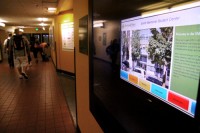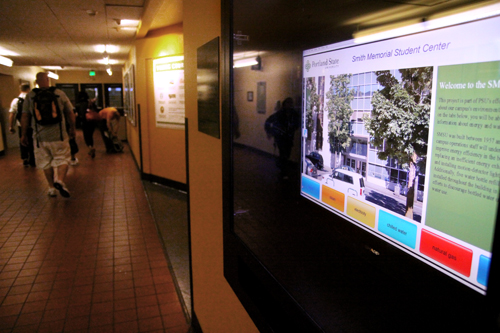After a year and a half of collaboration between the Institute for Sustainable Solutions and Facilities and Planning, the Smith Memorial Student Union has become the first building to be retrofitted to accommodate what is called a “green screen.” With sustainability in mind, the new green screen TV display outside the cafeteria tracks resource use throughout a building.
A dollars and cents guide
After a year and a half of collaboration between the Institute for Sustainable Solutions and Facilities and Planning, the Smith Memorial Student Union has become the first building to be retrofitted to accommodate what is called a “green screen.” With sustainability in mind, the new green screen TV display outside the cafeteria tracks resource use throughout a building.

The interactive screen shows real-time updates on steam, electricity, chilled water, natural gas and water use, as well as an outline for daily and monthly use. Under each heading, the screen outlines how the resource is used and shows a comparison to what the real-time usage equates to.
This “dollars and cents guide,” as one of the students at the unveiling called it, is designed in the hopes that being aware of resources used in the building will lead to cutting back on unnecessary resource use, leading to a decreased carbon footprint and avoiding needless spending.
Several other schools have installed green screens. They generally agree they’re worthwhile. When you take into account the ability to pinpoint problem areas throughout the day, the screen does make a lot of sense. You can’t reduce usage without knowing where the difficulties exist.
Ironically, the screen itself contributes to the building’s carbon footprint. As a student at the unveiling exclaimed, “We’re wasting electricity!” Putting up an actual screen has increased the building’s resource usage. Criticism about the green screen’s effect on resource use is legitimate.
Not only does the screen contribute to resource use, but a sizable amount of time, energy and money was put into installing the screen. Most new buildings already have systems for tracking resources in place. Retroactivly making the adequate changes part of the reason it has taken a year and a half to get the screen in place.
Whether the costs outweigh the benefits is entirely contingent upon whether or not tracking resources leads to change. Knowing that chilled water is used for air conditioning, and that one ton of ice is equivalent to 42 window AC units and that 703 pounds of coal is equal to 885 pounds of wood, doesn’t immediately reveal a way to decrease that amount. The green screen does not decrease resource use in and of itself. It is only effective if the information it provides is utilized.
Real-time tracking screens have been shown to encourage conservation. In 2010, the University of Central Missouri found the amount of electricity used by their green screen was more than made up for by implementing changes based on its readings. Through strategies outlined by the Clinton Climate Initiative to make their campus more sustainable, the university reduced its electricity use by 35 percent, natural gas by 40 percent and water use by 10 percent. That amounts to a $735,271 cost savings, 9.7 percent of which they attribute to adjustments made after discovering problem areas thanks to their green screens.
Hydro One, an electricity company in Ontario, found similar results when they had customers to use real-time feedback devices in their homes. The 2006 study found households reduced their electricity use by 6.5 percent over a two-and-a- half-year span of time.
Even in the testing phase, Smith’s green screen has proved beneficial. As an example, an unusual water usage spike was found to occur at 2 a.m. With no reasonable explanation for large amounts of running water in the middle of the night, Smith is already looking into the source of the problem. In this way, the green screen is accomplishing its goal. It isn’t until you are aware of the problem that you can find solutions for it.
Mark Gregory, associate vice president in Finance and Administration, said at the unveiling that the green screens are “very practical, very pragmatic.” He plans to put them in every building that is cost justified in doing so. With the seven to eight million dollars a year spent on energy, reducing the university’s carbon footprint is both environmentally and economically advantageous.
Gregory is optimistic the money being funneled into unnecessary resources can be put to better use. If the green screen highlights problem areas and progress continues to come up with solutions, then the screen serves its purpose. If the screen saves money that can be re-allocated into education, buildings and student services, as Gregory hopes it can, then it will be well worth the effort.




